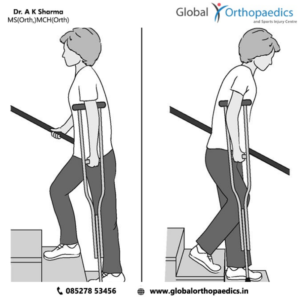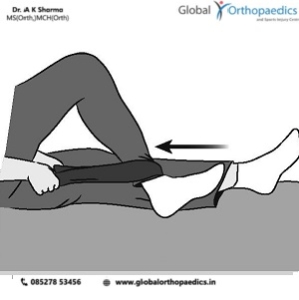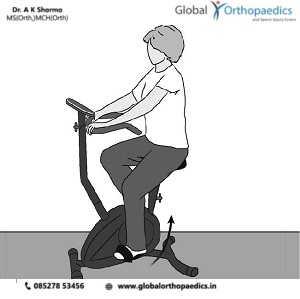Soon after your surgery happened, you will be able to begin your walk to short distances in your hospital room and perform some everyday activities. These early activities will definitely aid your recovery and help your knee regain its strength and movement.
Walking
Proper walking is far way better in order to help your knee recovery. At first, you will have to walk with a walker or crutches. Your Orthopedic surgeon or therapist will guide you about the weight to put on your leg.
You need to stand comfortably in a way that you erect with your weight evenly balanced on your walker or crutches. Put your walker or crutches ahead of you in a shorter distance; then reach forward with your operated leg with your knee straightened so the heel of your foot touches the floor first. As you move ahead, your knee and ankle will eventually bend and your entire foot will go on rest evenly on the floor. As you finish the step, your toe will lift off the floor and your knee and hip will eventually bend so that you can look forward to your next step. Remember, move and touch your heel first, then flatten your foot gradually and slowly, then lift up your toes off the floor.

Early on, walking will definitely help you regain movement in your knee.
Walk as rhythmically and smoothly as you can. Don’t hurry. Now you need to adjust the length of your next step and speed as conveniently to walk with an even pattern. As your muscle strength and endurance improve, you can spend more time walking. You will start to put more weight gradually on your leg. You should use a cane in the hand opposite your surgery and eventually walk without an aid.
When you will be able to walk and stand for more than 10 minutes and your knee becomes strong enough so that you will not carry any weight on your walker or crutches (often about 2 to 3 weeks after your surgery), you may begin using a single crutch or cane. You can hold the aid in the hand opposite to the side of your knee surgery. You need not limp or lean away from your operated knee.
Stair Climbing and Descending
The ability to go up and down stairs requires both strength and flexibility. At first, you will definitely go for handrail support and then gradually will be able to go only one step at a time. Remember that you always lead up or move up the stairs with your good knee and come down the stairs with your operated knee to prevent injury. Remember, “up with the good” and “down with the bad.” You need to seek help from someone until you have regained most of your strength and mobility.
Stair climbing is the best way to make your bones and muscles strengthen, strong and endurance activity. Do not ever try to climb the steps higher than the standard height i.e.; 7 inches and always use a handrail for balance. Hence, when you become stronger and more mobile, you can surely begin to climb stairs foot over foot.

Stair climbing and descending using a crutch
Advanced Exercises and Activities
Once you start regaining your independence for short distances and a few steps, you can eventually increase your activities. The pain of your knee problems before surgery and the pain and swelling after surgery might weaken your knee. The full recovery will take many months. The following exercises and activities will definitely help you recover fully.
Standing Knee Bends
You need to stand erect with the aid of a walker or crutches, and then lift up your thigh and bend your knee as much as you can. Hold it
Then straighten your knee slowly, and then touch the floor with your heel first for 5 to 10 seconds.
Repeat this several times until fatigued.
 Standing Knee Bends
Standing Knee Bends
Assisted Knee Bends
Lying down by your back, place a folded towel over your operated knee and drop the towel to your foot. Bend your knee and apply gentle pressure through that towel to increase the bend. Hold it for 5 to 10 seconds.
Repeat several times until fatigued.
 Assisted knee bend
Assisted knee bend
Knee Exercises with Resistance
You can put light weights around your ankle and can repeat any of the above exercises. These resistance exercises usually can start 4 to 6 weeks after your surgery happened. Use one- to two-pound weights initially, and then gradually increase the weight as per your strength returns.
Exercycling
Exercycling is the best activity that can help you regain your muscle strength and knee mobility.
Initially, adjust the seat height so that the bottom of your foot will start getting touching the pedal with your knee that too almost straight. Peddle backward first. Ride forward only after a comfortable cycling motion is possible backward.
As you gradually become stronger (at about 4 to 6 weeks) then you should slowly increase the tension on the exercycle also. Exercycle for 10 to 15 minutes twice a day, gradually build up to 20 to 30 minutes, 3 or 4 times a week.

Later on, exercycle will definitely help you build strength in the muscles around your knee.
Pain or Swelling after Exercise
You might experience knee pain or swelling after exercise or activity. You can be relieved from this by elevating your leg and applying ice wrapped in a towel.
Exercise and activity should consistently improve and prevent your strength and mobility.
For further questions or problems, you should contact your orthopaedic surgeon or physical therapist.


